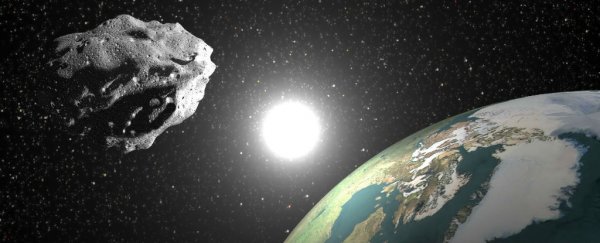Today NASA has taken it upon itself to release an official statement confirming that no asteroid will impact Earth this September, in response to a rumour that's gone viral stating that something very large is headed for Puerto Rico between 15 and 28 September 2015.
"There is no scientific basis - not one shred of evidence - that an asteroid or any other celestial object will impact Earth on those dates," Paul Chodas, manager of NASA's Near-Earth Object office at the Jet Propulsion Laboratory in the US, said in the statement.
So where did this rumour even come from? It's not entirely clear, but it's been circulating since at least June, predicting that impact in Puerto Rico will devastate the Atlantic and Gulf coasts of the US and Mexico, and have serious run-on effects in Central and South America.
"The scary predictions say that the asteroid will come down in the Atlantic Ocean near Puerto Rico, causing a '300-ft tsunami' and a 'Magnitude 12' earthquake which will lay waste to the eastern seaboards of the US, Mexico, and central and southern American nations (European nations will be devastated, specifically Spain, Holland and England, too)," the Astronotes blog says in describing this rumour. "Thirty million lives will be lost in the month after the impact, and 40 million more are destined to die from plagues and in civil disorder in the following seven months."
Kelsey Campbell-Dollaghan reports for Gizmodo that conspiracy theory website, InfoWars, has played a major role in perpetuating the myth. "We are simply taking a look at what has been said," InfoWars' John Bowne says in a video about the non-existent asteroid strike. If you want to get an idea of what Bowne's going on about, head to Gizmodo, but trust us when we say you'll probably come out of it feeling noticeably dumber, so proceed with caution.
Back to reality, and according to NASA's Near-Earth Object Observations Program, there have been no asteroids or comets observed that would impact Earth anytime in the foreseeable future. "All known Potentially Hazardous Asteroids have less than a 0.01 percent chance of impacting Earth in the next 100 years," NASA reports.
While there are certainly holes in the process of Near-Earth Object detecting due to the fact that there are thousands of objects zipping by and a limited amount of resources to track them, one thing we know for sure is that if one's likely to hit us in the near future, we'll be all over it. "If there were any object large enough to do that type of destruction in September, we would have seen something of it by now," Chodas said.
As of 18 August 2015, 12,992 Near-Earth Objects have been discovered by the Near-Earth Object Program, 875 of which are asteroids with a diameter of approximately 1 kilometre or larger. Some 1,607 of these have been classified as Potentially Hazardous Asteroids, and these are the ones that scientists are keeping an extra close eye on, for obvious reasons.
Being part of a bustling cosmic neighbourhood shouldn't be a scary thing anyway; it's fascinating to discover what's zooming all around us. If you want to find some of these Near-Earth objects for yourself, NASA's launched an app that gives amateur astronomers the opportunity to discover asteroids. All you need is an Internet connection and a telescope.
If you're more the sit-back-and-wait-for-NASA-to-find-them type, check out the video below, which visualises space if all the Near-Earth Objects were visible. We might not have found aliens yet, but we're certainly not alone:
